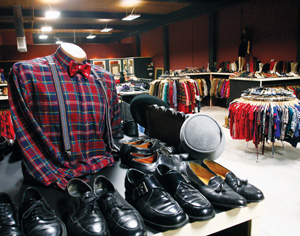Features & Columns
Street of Dreams
 VINTAGE NOTIONS: The new Black & Brown at 850 The Alameda
signals the changing nature of the venerable avenue.
VINTAGE NOTIONS: The new Black & Brown at 850 The Alameda
signals the changing nature of the venerable avenue.
OVER THE wasted years, more than a few armchair urban planners have suggested that The Alameda between Race Street and the HP Pavilion should blossom into something unique—something urban and funky and special.
This grand boulevard of squandered potential lays claim to numerous eclectic old buildings exhibiting a variety of architecture. For years, one end has already included Recycle Books and Greenlee's Bakery. Crema Coffee also occupies a sweet spot. One of San Jose's most historic avenues, the rest of The Alameda still boasts numerous stately mansions of old. But this more commercial stretch has been neglected for years. Things could be changing for the better, though, based on some more independent businesses that recently arrived.
Some background: Since the street should indeed function as a major gateway to downtown, a Caltrans grant was awarded in 2009 to produce a 100-page conceptual framework of what the street might someday look like.
Overdone with declarative criteria for appropriate street furniture aesthetics, proper angles for lighting, suitable species of flowers for conversation ambience and direct orders for how the newspaper racks must be consolidated, the document takes Disneyland-style homogenization to staggering new dimensions with stuff like this: "Color, finish and style shall complement existing light poles and fixtures" and "street furniture elements therefore include features that extend beyond simple utilitarian function to include a restrained degree of ornamentation that relates to the historic character of the area ... " And so on. Sheesh.
Of course the street needs to be more pedestrian friendly, but this stretch of The Alameda has potential precisely because almost every building looks different. That is, the street has character. Any new concept or plan should take advantage of that, not bury it with giddy cosmetic filler.
But aside from all that, judging by some new tenants, it's easy to see how, if the landlords care enough, the entire street just might turn into a really cool, independent, alternative substratum. If you walk down the sidewalk for 10 minutes and employ some right-brain thinking, you'll see the big picture, based on a few current businesses and those who've moved in.
I don't mean "alternative" in some antagonistic sense (well, maybe a little). I use that word to mean an eclectic mixture of independent tenants who, along with the residents, want to see a pleasantly off-kilter neighborhood with a variety of interesting architecture and a unique-looking urban stretch of road that evolves organically.
That is, not some city-designed faux urban village with cookie-cutter condo-and-retail facades looking as if they were purchased at Toys "R" Us and forced-crammed onto a landscape where they don't fit. Believe me, if the city had its way, that's exactly what would happen.
Over at 1020 The Alameda, a small boutique and gallery combo, the Usuals, has already been open for at least a year. It hosts art receptions every fourth Friday of the month and has almost 1,000 Facebook fans. Co-operator Mari Millares says she would love to see the street evolve into a funky independent locale.
"I hope it grows organically," she said. "It could turn into something like Valencia Street in San Francisco."
Just a few weeks ago, Black & Brown, a modern and vintage clothing boutique, moved from its former location into a gorgeous 5,200-square-foot space at 850 The Alameda, near Sunol. Inside, it looks like a rectangular airplane hangar—cavernous, industrial and groovy. Black & Brown now has much more room to expand, if need be.
On opening day, I waltzed in and the scene blew me away. I spotted a $400 pair of Italian shoes for $95—in good condition. Loads of affordable sweaters, coats and dress shirts lined the walls. There were even eight fitting rooms. Employees were still installing wall fixtures, but the place was hopping.
With that, I will now end by reminding folks that The Alameda also lays claim to one of our most celebrated local landmarks, the statue of Babe the Muffler Man. It doesn't need olive trees, red fescue and lavender to make it look better.


